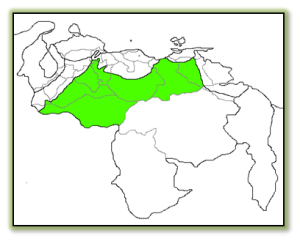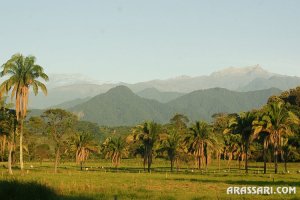The llanos are constituted by 7 states which are Apure, Barinas, Portuguesa, Cojedes, Guárico, Anzoátegui and Monagas. All of them have mainly flat lands and are divided into three areas:
- The western llanos: are formed by the states of Apure, Barinas and Portuguesa.
- The central llanos: are formed by the states of Guárico and Cojedes.
- The eastern llanos: are formed by the states of Anzoátegui and Monagas.
Flora and fauna
The Llanos have huge plains full of trees and flowers of different kind such as: the Cork Oak (Alcornoque), the Merecure, the Saman, the Water Hyacinth, the Hoya Carnosa (Flor de Nácar), the Kermes Oak (chaparro), the Salado, the Cañafístolo Llanero and the Copernicia Tectorum (Palma Llanera).
During summer tourists can find countless animal species gather near small lakes enjoying the warmth weather, and the main ones are: The Capybara (Chigüire), the Anteater (Oso Hormiguero), the Frog named “Rana Platanera”, the Deer (Venado), the White Caiman (Baba), the Collared Peccary (Báquiro), the fish named “Caribe”(it is a kind of piranha), the Butterfly Peacock Bass (Pavón), the American Black Vulture (Zamuro), the Grey Heron (Garza Real), the Yellow-headed Caracara (Caricare Sabanero; also called, Chigüare), the Hoatzin (Chenchena) and the Maguari Stork (Gabán).
The climate
The llanos have an intertropical climate with an annual average temperature of 27°C (81°F). On the other hand, it has a rainy season in the southern sector and a severe drought season in the northern sector.
The culture
In The Llanos is common to find vigorous people with rural habits that have highly marked the Venezuelan culture. It is commonly thought that the “llaneros” are brave men riding horses like cowboys; fighting against the nature and dominating animals. As well, it has also been the own stereotype of Venezuelans in the country, taking into consideration this type of culture as part of their national identity.
Its autochthonous music is Venezuela official music and it is produced with native instruments such as: maracas harp and a little guitar named “Cuatro”. Additionally, its folk dance is the “Joropo” and its traditional clothing is the “Liquiliqui” which is a type of men suit.
Another traditional activity that people make in the llanos is the “Coleo”, which is similar to rodeo. Coleo consists of a llanero who is riding a horse and pulling the tail of a bull until it falls to the ground. The stadiums especially built for such activity are called “Mangas”.
The traditional craftsmanship is made by skilled natives using ancestral techniques inherited through generations. The materials they used to make craftsmanship are: clay, seeds, pieces of palm and moriche palm, wood, leather, seashell (guarura), jet, among others; native made hats, clay pots, clay cups, clay vase, hammocks, espadrilles (alpargatas), leather crafts, wicker baskets, etc.
The cookery of the llanos is characterized for the use of river fish, meat, yucca, rice and corn. The yucca is used to make cassava bread which is typically consumed in many traditional dishes made by Venezuelans, as well as the pre-cooked cornmeal for arepas. In addition, the llanos offer typical dishes made of capybara meat named “pisillo de chigüire”, turtle pie “pastel de morrocoy”, among others.
Members:
Mariana Bengochea
Marzia De Sousa
María C. González
Rafael Quintana
Cynthia Quintero

